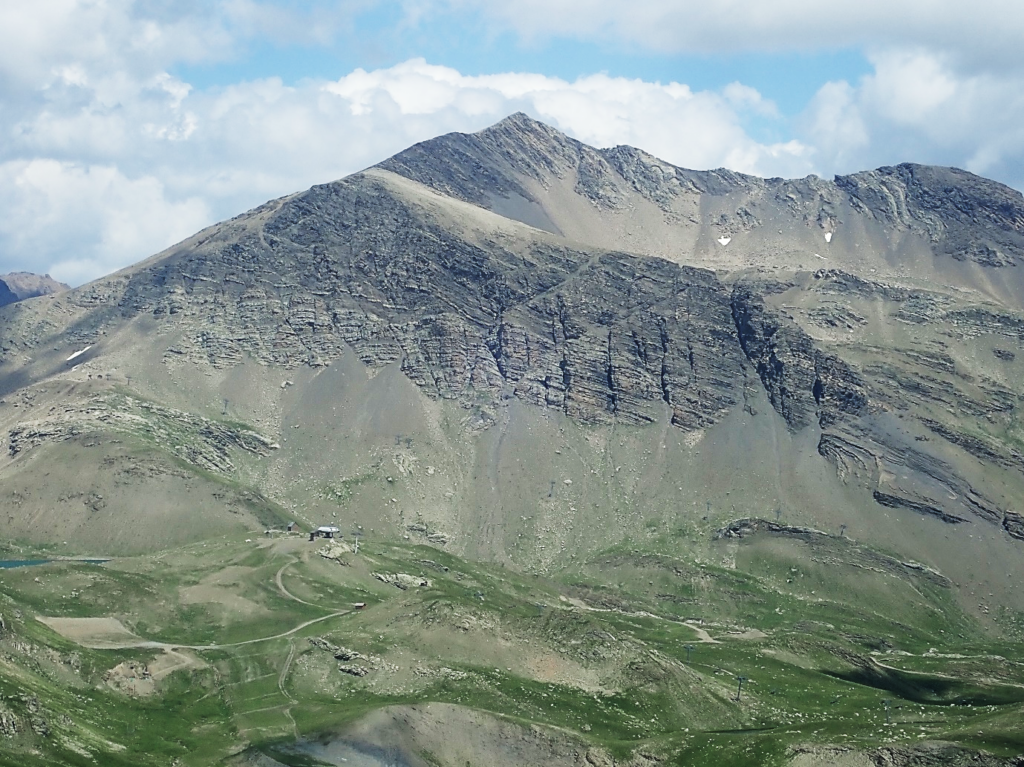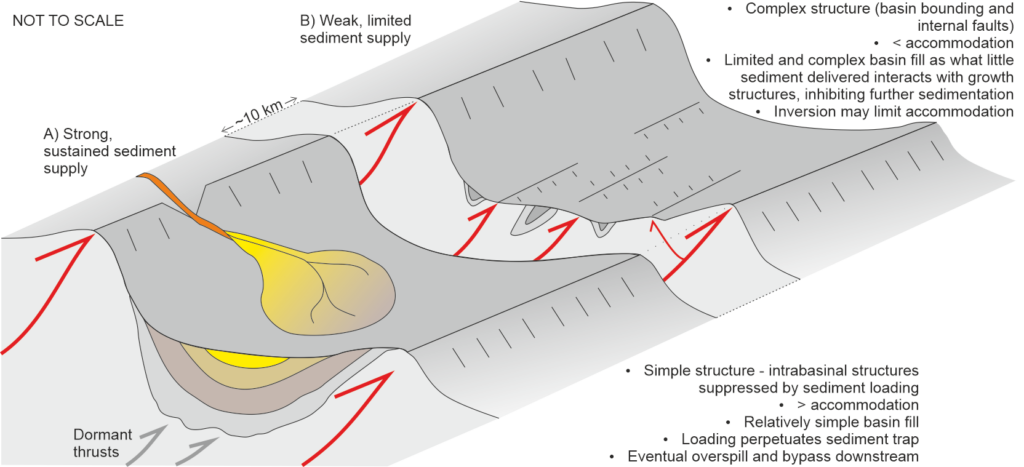Sediment – structure interactions in the development of the Alpine foredeep
Highlights:
- Opportunity to undertake field and laboratory investigation of stunning datasets from the French Alps (Fig. 1).
- Join an integrated research group, with links to international researchers and industry.
- Attend international conferences in Europe, the US and elsewhere.
- Project sits alongside linked research as part of a larger research programme.
- Opportunities for career development (academia, internships, industry and beyond).

Rationale:
Understanding the origin and evolution of sedimentary basins underpins much of earth science and is critical for evaluating the distribution of many natural resources, e.g. water and geothermal energy (Jessop & Majorowicz 1994) and for climate mitigation efforts, e.g., carbon capture and underground storage (Marshall et al., 2016). New theories on the formation and development of sedimentary basin are arising, particularly regarding the influence sedimentation may have on structure growth (Totake et al., 2018; Butler 2020). That structure growth may be modulated by sedimentation (McArthur et al., 2022) has profound implications for the structural and sedimentary evolution of a basin (Fig. 2). The primary goal of this project is to study the stratigraphic evolution of a series of linked sedimentary basins, to understand how deep-water sedimentation interacted with structure growth and vice versa.
This project will help develop our fundamental understanding of how deep-water sedimentary processes respond to confinement. The project will also help develop an applied understanding of the fill and rock properties of sediments in confined basins, which are hosts of conventional resources (e.g., Totake et al., 2018), sinks of organic carbon (e.g., McArthur et al. 2016), and potential hosts of man-made pollutants (e.g., Kane et al. 2020). This project will benefit from field studies in the famous Alpine foredeep basins of SE France (Fig. 1 & 3); decades of prior studies by the wider research team provide a rigorous stratigraphic framework for the study.
Additionally the study may exploit subsurface data of confined basin-fills from offshore New Zealand, including seismic, well, and core data, to characterise the interaction of structure growth and sedimentation in subsurface architecture. Additional techniques that may be applied include palaeo-magnetism, anisotropy of magnetic susceptibility, biostratigraphy, and relational databasing to characterise the facies and architecture of the studied systems. However, the project is designed to be flexible, and can be adapted to align with the particular interests of the candidate.

Aim and objectives:
The main aim of this project is to analyse the stratigraphic fill of a series of linked basins in the Annot fairway of SE France to reconcile the role of sedimentation on structural evolution of a deep-water fold and thrust belt. Recent studies have shown the southern basins to originate from salt tectonics (Brooke-Barnett et al., 2023), whilst the northern basins developed as thrust-top syncline basins, with syn-sedimentary fold and thrust development (Butler et al., 2020).
For complimentary analogue studies, the research will involve development and employment of the Deep-Marine Architecture Knowledge Store (DMAKS), a relational database designed and populated by members of Turbidites Research Group at Leeds. Collected data will be used to address research questions (directly as part of this project; see below), but also more widely within the research group to inform modelling of subsurface basin fills, and process-based experimental and numerical modelling of confined basin fills. Both fundamental and applied research themes can be investigated as part of the project, and these may include, but are not limited to, any of the following topics and related research questions.
- What role does sedimentation have on the development of sedimentary basins? Studies are showing that focusing of sedimentation in particular areas may drive localised subsidence, alter stress regimes, and potentially initiate feedback loops that maintain basin bounding structure growth (McArthur et al., 2022). Hence sedimentation may promote the development of depocentres and discrete sedimentary basins (Fig. 2). Can this study help provide data for modelling of confined basin fills in the subsurface?
- What is the relationship of individual fault growth to sedimentation? The growth and resulting style of faulting, e.g., ramp vs. flat trajectory, has been shown to be influenced by the volumes and types of sediment loaded onto growth structures (Butler, 2020), based on analysis of structures in different margins. These models can be more robustly tested by examination of different structures (e.g., normal faults, thrusts, salt related faults) in the sedimentary system. Specifically, does the style of sedimentary system, e.g., pelagic dominated, turbidite dominated, mass-transport dominated, each with different sediment properties, sedimentation rate etc., influence different styles of faulting? What geological factors should we consider when selecting analogues for confined basin fills in the subsurface?
- Does the style of faulting and hence degree of confinement influence deep-water sedimentary transport and deposition? e., under high rates of confinement, sheet like systems may develop (e.g., Amy et al., 2007), whilst under less degrees of confinement lobe systems may develop (e.g., McArthur et al., 2021). At which stage of the basin evolution are channels most likely to form? Can we improve on the population of reservoir modelling workflows (applicable to conventional resources, emerging energy sources such as geothermal, and groundwater extraction) in confined settings?
- How do facies tracts evolve with active structures? Complicated changes in the sedimentary facies and beds have been documented adjacent to active structures, e.g., with mass-wasting from active faults, or the transformation from turbidity currents to hybrid flows approaching onlap surfaces (Patacci et al., 2014). Can we improve predictions of stratigraphic terminations approaching dynamic structures? Stratigraphic heterogeneity is critical for correctly understanding climate mitigation efforts, such as carbon capture and storage.

Methodology:
Four principal methods will be applied to answer the questions above:
- Field studies will be undertaken in St. Antonin (Jourdan et al., 2018), Annot (Puigdefàbregas et al., 2004), Chalufy (Bakke et al., 2013), Eastern Champsaur (Vinnels et al., 2010) and Aiguilles d’Arves basins of SE France to characterise the sedimentary fill and structural evolution of each confined basin. This will involve geological mapping, logging and potentially sampling of event beds across the basin fill. Deployment of an uncrewed aerial vehicle (UAV) will allow collection of high resolution imagery and may be used to build a 3D digital outcrop models.
- Subsurface studies of confined basin-fills from the offshore New Zealand, may be undertaken to understand basin fills at seismic scale. The subsurface and outcrop studies may act as analogues at different hierarchies of data resolution.
- The data will be organised and stored in a relational database (DMAKS). This database will also provide analogues for the study datasets to compare basin fills in different settings.
- Laboratory studies of samples for magneto-stratigraphy, anisotropy of magnetic susceptibility, petrographic studies, and potentially biostratigraphy will be used to characterise the age and composition of the studied basins.
Eligibility and funding:
Applicants should have a BSc degree (or equivalent) in geology, earth sciences, geophysics or a similar discipline. An MSc or MGeol in applied geoscience or petroleum geoscience (or similar) would be an advantage. Experience of using GIS and seismic interpretation software would be useful, though is not essential. Skills in field-based geological data collection and field sedimentology and stratigraphy are desirable. Funding is competitively provided via the NERC DTP scholarship scheme. In the event of funding, full fees, maintenance and project costs will be covered. Self-funded or other means of funding are also welcome.
Training:
The successful applicant will join a large and vibrant research environment as part of the inter-disciplinary Turbidites Research Group, which is part of the wider Sedimentology Group at the School of Earth and Environment, University of Leeds. The TRG has a number of on-going research projects related to deep-marine clastic sedimentology via field studies, physical and numerical modelling, and seismic studies. The project will provide specialist scientific training, as appropriate, in: i) morphometric analysis of landscape features with a range of software (e.g. ArcGIS, Matlab or Python); ii) geological interpretation of seismic datasets using a range of software (e.g. Petrel, Paleoscan); iii) relational-database theory and practice (e.g. MySQL); iv) statistical analysis of large datasets; and potentially field-based techniques for the sedimentological and architectural analysis of clastic successions. The mixed pure- and applied-science nature of this research project will enable the candidate to consider a future career in either academia or industry. In addition, the candidate will have access to a broad spectrum of training workshops provided by the Faculty that include an extensive range of training workshops in statistics, through to managing your degree, to preparing for your viva (http://www.emeskillstraining.leeds.ac.uk). The successful candidate will be strongly encouraged and supported to present their results at international conferences and publish the outcomes of their research in international journals.
Recommended Reading:
Amy, L. A., Kneller, B. C. and McCaffrey, W. D. (2007). Facies architecture of the Gres de Peira Cava, SE France: landward stacking patterns in ponded turbiditic basins. Journal of the Geological Society 164: 143-162. http://dx.doi.org/10.1144/0016-76492005-019
Bakke, K., Kane, I.A., Martinsen, O.J., Petersen, S.A., Johansen, T.A., Hustoft, S., Jacobsen, F.H. and Groth, A., 2013. Seismic modeling in the analysis of deep-water sandstone termination styles. AAPG bulletin, 97(9), pp.1395-1419. https://doi.org/10.1306/03041312069
Brooke-Barnett, S., Graham, R., Lonergan, L. and Csicsek, L.A., 2023. Salt tectonics along a strike-slip fault system in the sub-Alpine chains of southeastern France, from the Triassic to the Oligocene. AAPG Bulletin, 107(1), pp.87-122. https://doi.org/10.1306/08042221102
Butler, R.W., 2020. Syn-kinematic strata influence the structural evolution of emergent fold–thrust belts. Geological Society, London, Special Publications, 490(1), pp.57-78. https://doi.org/10.1144/SP490-2019-14
Butler, R.W., Lickorish, H.W., Vinnels, J. and McCaffrey, W.D., 2020. Untangling the Annot sand fairway: structure and stratigraphy of the Eastern Champsaur Basin (Eocene–Oligocene), French Alps. Journal of the Geological Society, 177(6), pp.1197-1209. https://doi.org/10.1144/jgs2020-015
Jessop, A.M. and Majorowicz, J.A., 1994. Fluid flow and heat transfer in sedimentary basins. Geological Society, London, Special Publications, 78(1), pp.43-54. https://doi.org/10.1144/GSL.SP.1994.078.01.05
Jourdan, S., Bernet, M., Hardwick, E., Paquette, J.L., Tricart, P., Senebier, F. and Coeur, F., 2018. Geo-thermochronology of the Saint Antonin basin, south-eastern France. Bulletin de la Société Géologique de France, 189(3). https://doi.org/10.1051/bsgf/2018013
Kane, I. A., Clare, M. A., Miramontes, E., Wogelius, R., Rothwell, J. J., Garreau, P. and Pohl, F. (2020). Seafloor microplastic hotspots controlled by deep-sea circulation. Science 368(6495): 1140-1145. https://doi.org/10.1126/science.aba5899
Marshall, J.D., Tucker, O.D. and Lovelock, C.E., 2016. Goldeneye: modelling a depleted field for carbon capture–how much uncertainty is left?. Petroleum Geoscience, 22(1), pp.37-45. https://doi.org/10.1144/petgeo2014-072
McArthur, A. D., Kneller, B. C., Wakefield, M. I., Souza, P. A. and Kuchle, J. (2016). Palynofacies classification of the depositional elements of confined turbidite systems: Examples from the Gres d’Annot, SE France. Marine and Petroleum Geology 77: 1254-1273. https://doi.org/10.1016/j.marpetgeo.2016.08.020
McArthur, A.D., Bailleul, J., Mahieux, G., Claussmann, B., Wunderlich, A. and McCaffrey, W.D., 2021. Deformation–sedimentation feedback and the development of anomalously thick aggradational turbidite lobes: Outcrop and subsurface examples from the Hikurangi Margin, New Zealand. Journal of Sedimentary Research, 91(4), pp.362-389. https://doi.org/10.2110/jsr.2020.013
McArthur, A.D., Crisóstomo‐Figueroa, A., Wunderlich, A., Karvelas, A. and McCaffrey, W.D., 2022. Sedimentation on structurally complex slopes: Neogene to recent deep‐water sedimentation patterns across the central Hikurangi subduction margin, New Zealand. Basin Research, 34(5), pp.1807-1837. https://doi.org/10.1111/bre.12686
Patacci, M., Haughton, P. D. W. and McCaffrey, W. D. (2014). Rheological complexity in sediment gravity flows forced to decelerate against a confining slope, Braux, SE France. Journal of Sedimentary Research 84(4): 270-277. https://doi.org/10.2110/jsr.2014.26
Puigdefàbregas, C., Gjelberg, J. and Vaksdal, M., 2004. The Grès d’Annot in the Annot syncline: outer basin-margin onlap and associated soft-sediment deformation. Geological Society, London, Special Publications, 221(1), pp.367-388. https://doi.org/10.1144/GSL.SP.2004.221.01.20
Totake, Y., Butler, R.W., Bond, C.E. and Aziz, A., 2018. Analyzing structural variations along strike in a deep-water thrust belt. Journal of Structural Geology, 108, pp.213-229. https://doi.org/10.1016/j.jsg.2017.06.007
Vinnels, J.S., Butler, R.W., McCaffrey, W.D. and Lickorish, W.H., 2010. Sediment distribution and architecture around a bathymetrically complex basin: an example from the eastern Champsaur Basin, SE France. Journal of Sedimentary Research, 80(3), pp.216-235. https://doi.org/10.2110/jsr.2010.025
Further Information:
For more information about this opportunity and related TRG activities contact:
Adam McArthur a.mcarthur@leeds.ac.uk, http://trg.leeds.ac.uk/
